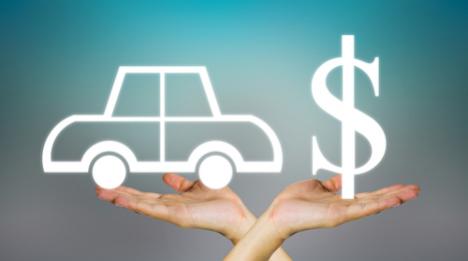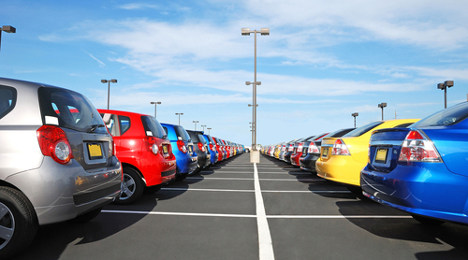KAR Auction Services announced that four of its leaders from KAR and its ADESA and Automotive Finance Corp. business units will be featured speakers and panelists at the National Independent Auto Dealers Association Convention & Expo this week in Las Vegas.
The vehicle remarketing and technology solutions provider’s speakers include KAR chief economist Tom Kontos, AFC chief operating officer Joe Keadle, ADESA director of dealer consulting services Doug Hadden and AFC vice president of operations Johnny Shroyer.
KAR said Kontos and Keadle plan to discuss the current and anticipated economic strengths, weaknesses, opportunities and threats related to independent dealers on Thursday from 8:30 a.m. to 9:30 a.m. (PDT).
On Tuesday, Hadden will deliver a presentation on higher net profits that examines different ways to navigate through lower margins while achieving higher net profits and Shroyer will join other industry experts on the Floorplanning Tips for the Independent Dealer panel.
Both of those are on Tuesday from 4:15 p.m.to 5:00 p.m. (PDT).
For more information about the convention and this year’s speakers, visit www.niada.com.
SoCal Penske Dealer Group announced it acquired the Fuller Ford, Fuller Honda, Fuller Kia and Fuller Collision Center in Chula Vista, Calif., further expanding its footprint in the Southern California market.
The former Fuller locations have been rebranded as Penske Ford Chula Vista, Penske Honda Chula Vista, Penske Kia Chula Vista and Penske Collision Center Chula Vista.
“Closing this purchase represents a significant milestone for SoCal Penske Dealer Group and gives us deeper roots in the San Diego retail market,” the group’s chief executive officer, Roger Penske Jr., said in a new release. “Fuller Motors is one of the largest employers in the City of Chula Vista.
“A great deal of effort from both sides went into ensuring a smooth transition for the Fuller employees. We are thrilled to now count their employees, guests and neighbors among our friends and family and look forward to developing strong ties to the local community.”
SoCal Penske now has a total of 14 dealerships in Southern California since acquiring the Fuller stores.
Galpin opens exclusive Kia dealership in Southern California
Galpin Motors’ latest franchise, Galpin Kia in North Hills, Calif., is just adjacent to Galpin’s main campus on Roscoe Boulevard and finished last month as the No. 8 Kia dealer in the country.
The new store is the exclusive Kia dealership in San Fernando Valley County and the 12th franchise to join Galpin’s collection of brands, which includes Ford, Lincoln, Mazda, Aston Martin, Honda, Subaru, Volkswagen, Lotus, Volvo, Jaguar and Spyker.
Galpin Kia officially opened in October and its inventory is made up of Kia’s full line of cars and SUVs.
“We couldn’t be more excited about the opening of our Kia dealership,” Galpin Motors president and chief operating officer Beau Boeckmann said in a news release announcing the opening. “I just returned from Seoul, Korea, where I was able to see the amazing Kia factory, its beautiful cars and wonderful designs.
“The automaker has been incredibly successful at building a line of stylish, quality cars that are still attainable for consumers. Having a Korean family, I feel especially honored to add a Korean brand into our Galpin family.”
In addition to its collection of franchises, Galpin Motors also operates its well-known customizing shop, Galpin Auto Sports (GAS). GAS is the former home to MTV’s Pimp My Ride and a popular shop for a number of Hollywood’s elite, according to the group.
As the mobile auction format continues to attract more dealers across the country, companies within the industry are continuing to push the wholesale auction experience and communicate the benefits that many used-car managers praise.
“We’re averaging well over 60 mobile auctions per month around the country right now, and that’s a huge increase from just barely over 20 a year and a half ago,” said Manheim’s Randy Beil. “Our core product is what we call true mobile; that is where we bring either a trailer or a bus fully equipped to handle an auction, simulcast, and an auctioneer.”
Beil, who is vice president of local/mobile at Manheim, said a large part of what he and his team does is to grow Manheim into different markets across the country where the company might not already have a presence.
“What we’re really trying to do is create a model to get into these markets, partner with dealers we already do business with and try to get more of their low-end business,” Beil said. “That’s exactly what we’ve done largely in our growth in the past year and a half.”
He said Manheim has been able to get in many cities through existing partnerships with dealer groups.
The company’s mobile sales are launched by two different platforms it refers to as true mobile and mini mobile. True mobile is its largest and core product.
“You get 100 percent of what you see in the auction but you bring it to the dealership, so we bring the auction to the dealership, and that’s what we call true mobile because that’s exactly the core of our product,” Beil said.
“We bring that auction to the dealership and we largely sell their trade-ins from that store or four or five stores at that auction. Some locations host sales once a week, sometimes we do it every other week, sometimes we do it once a month. It all depends on the volume that dealership has.”
Manheim has been expanding its mini mobile product over the past six months, according to Beil.
What differentiates them from a true mobile is it’s much more of a permanent auction, such as a two, three or four-lane facility.
“This is a basically a full on auction as far as a dealer is concerned, often it’s a one, two, three-lane auction that we get into a market and we open up a small auction and it’s a stand-alone auction for all practical purposes, but internally from our standpoint it’s kind of like a satellite auction because its’s still managed by a parent auction,” he said.
“We rely on the parent auction’s staff to help support the functions of the satellite auction.”
Of all the cars Manheim sells at its mini locations, all of the revenue and all of the expenses flow up to that parent auction.
“We brand them and we market them, we advertise them, it’s a stand-alone auction that looks a like just an others,” Beil said.
Mini mobile auctions bring in about 40 to 50 different sellers to each sale, while true mobile is usually one consigner, according to Beil.
The fundamentals of mobile
Digital technology is a fundamental resource mobile actions depend on, says Ryan Rickey, general manager of XLerate Group’s Your Auction Mobile sales.
“Traditional brick-and-mortar, where dealers go in and can check out cars week-in and week-out, sometimes these mobile auctions have a greater travel time. Rickey said. “We depend on the internet and our marketing tools via the internet so people can check out extensive pictures, pre-sale inspections — things of that nature, just to give them the confidence to bid online and or show up in person.”
Your Auction Mobile’s sales allow dealers managers to remain in their stores and focus on retail as opposed to running the “gauntlet of auctions,” he said.
“In today’s climate, post the recession, secondary lending became more aggressive and dealers started holding on to that c-paper. Having the auction onsite gives you a chance to potentially retail some of those vehicles you'd otherwise be wholesaling weekly,” Rickey said.
Taking it to a higher level
Auctions In Motion (AIM) started in 2006, as a completely mobile sale. It was purchased by what is now known as XLerate in in 2012.
“We literally went to the dealers’ lots and we would set up our pop-up tent along with a couple of trailers that would support the auction,” said George Pero, AIM founder and general manager at Corry Auto Dealers Exchange, an XLerate auction.
“The business gained momentum,” Pero continued. “First it was a bi-weekly sale and then it was a weekly sale and then it gained so much attention and critical mass business that we thought that the next step in progressing the expansion and growth of the business was to get a single free-standing facility where we would run a one-lane auction.”
When asked about any challenges associated with mobile sells, Pero said: “Challenges really aren’t that many or significant; I would say running out of space when you have a lot of consignment.
“For consignment, for a one-lane mobile sale is 150 to 200 units, they become so popular that we run out of space.”
Challenges remain
The challenges associated with mobile sales are similar to those of any auction, according to Jane Morgan, who is president of specialty auction divisions at ADESA and oversees mobile auction offerings and helps in geographic expansions.
“Educating dealers on how mobile sales work, why they should try mobile sales, and how mobile sales can benefit their business may be considered a challenge,” Morgan said.
Space may be a challenge, depending on the size of a dealer’s lot or the type of inventory, like if it is a mobile auction for heavy-duty trucks, for example.
Mobile auctions entails working with the seller to select their inventory in advance so it’s competitive in the marketplace, Morgan explained
She said selecting inventory far enough in advance is important to allow time to best match the right buyer to the right product.
Rickey added that a challenge he recognizes is larger competitors within the industry. “As an auction company, you see groups such as the larger groups in the industry — AutoNations, CarMaxes, they’re figuring out ways to do it themselves,” he said.
“The margins I think, are getting skinnier,” Rickey went on to say. “Profitability has to change, we just need to be aggressive and provide a service above and beyond our competition.”
Along with announcing the newest addition to its national member benefit program the National Independent Automobile Dealers Association highlighted that for the fifth consecutive year, ADESA, AFC and IAA — all part of KAR Auction Services — will auction off a premier vehicle during the NIADA Convention and Expo to benefit the NIADA Foundation.
This year's vehicle is a red 2016 Nissan Frontier SV crew cab pickup with a 4.0L V6 engine, 5-speed automatic, 26,167 miles on the odometer and gray cloth interior.
The truck will be on display in the Expo Hall during the Convention, which begins Monday at The Mirage in Las Vegas. The Expo opens the next evening.
The auction will be held at 1:30 p.m. next Thursday at the NIADA Dealer Lounge in the center of the Expo Hall.
ADESA will transport the vehicle for free for the winning bidder to any location in the continental U.S.
All proceeds from the auction will benefit the NIADA Foundation, which spearheads the association’s commitment to charitable giving as well as awarding scholarships to deserving college-bound students across the nation and providing training and educational opportunities to automobile dealers and the general public.
Past foundation activities include significant donations to charities such as the Heart of a Warrior Foundation, contributions for disaster relief efforts and endowments for university scholarships.
Over the past four years, the ADESA/AFC/IAA-sponsored auctions at the NIADA Convention have raised a total of $97,200 for the NIADA Foundation. During last year's event, a 2015 Chrysler 300 Limited sold for $27,500.
Net Driven partners with NIADA
In other news, Net Driven has joined NIADA’s national member benefit program to provide association members with a variety of digital marketing solutions, from custom websites and SEO to social media and online reputation management.
Net Driven provides digital marketing services exclusively to the auto industry, working with more than 3,000 automotive businesses across North America to deliver custom, mobile-first website design, Internet marketing and SEO, social media management, call tracking and recording, online review management and more.
Net Driven's digital marketing capabilities are coupled with a 97 percent retention rate and customer support.
“Partnering with NIADA creates an opportunity for us to help its members by providing a results-driven program to achieve online success,” Net Driven general manager Eric Wellner said. “The website is just the beginning. What we offer NIADA members is a true business partner that will invest in their online success and work with them every step of the way. We don’t succeed unless they succeed. It’s that simple.”
Association members can take advantage of an immediate cost savings of up to $1,500 and a monthly savings of $25 on Net Driven's services through NIADA’s BenefitHub or by calling Net Driven directly.
Net Driven will set up a free one-on-one demo for NIADA members and offers an evaluation of their unique business needs to develop a custom solution.
“Net Driven's three-part solution is focused on one thing: results,” NIADA senior vice president of member services Scott Lilja said. “One hundred percent of what they do is focused on our industry, so we know our members are in good hands.
“Having a successful online presence today is about much more than just a website. Net Driven can provide services to help our members be present and get found online, and develop a positive and trustworthy online reputation,” Lilja went on to say.
For more information or to request a free personal demo, call (877) 860-2005 or visit netdriven.lpages.co/niada.
NIADA CPO program gets boost from eBay Motors
Furthermore, NIADA said it has launched an enhancement to its Certified Pre-Owned program, powered by eBay Motors.
The improved NIADA CPO program can enable independent dealerships to effectively manage and merchandise inventory, which can help increase sales, profits and inventory turn.
For eBay shoppers, the NIADA CPO program will continue to add quality inventory and instill purchasing confidence from reputable independent dealers.
“Through this improved NIADA CPO program, we're continuing to supply auto dealers with the tools and technology that support enhanced inventory management and lead generation," eBay Motors general manager of vehicles Tony Hoang said.
“We constantly focus on offering buyers the best selection and a convenient, secure experience. Working with NIADA dealers provides buyers additional peace of mind and access to a large selection of certified pre-owned vehicles from trusted independent auto dealers,” Hoang continued.
This strengthened CPO program can give more power to dealers who manage listings on eBay Motors by providing tools that:
—Efficiently export CPO inventory to third-party digital marketing auto portals, including dealers' own websites.
—Process and print standardized buyers guides and window labels.
—Report inventory movement and pricing trends.
The NIADA CPO program’s new merchandising platform can offer value to dealerships and can help drive increased inventory turnover, online lead traffic, market intelligence and cost reductions and efficiencies.
“This new platform builds on the success of previous initiatives of the NIADA Certified program,” Lilja said. "Through this enhanced digital platform, NIADA member CPO program clients will gain increased insights to traffic and inventory leads, which we believe will lead to increased sales.”
For more information, call (877) 310-0288.
While differing on how first-quarter activity unfolded, both Kerrigan Advisors and Haig Partners shared upbeat assessments of dealership buying and selling activity for the rest of 2017 as each used the adjective, "robust."
First, at Kerrigan Advisors, the firm reported that the action of dealerships changing hands “remains robust” for Q1 in spite of slowing vehicle sales and a slight dip in Blue Sky Values. According to The Blue Sky Report, a Kerrigan Quarterly, any negative headwinds are being offset by high dealership real estate prices.
Outpaced by the private companies in acquisition activity, Kerrigan Advisors indicated that publicly traded dealer groups are directing their focus to non-U.S. acquisitions. According to the report, macro-economic conditions, which offer opportunities for both optimism and pessimism, are contributing to a high level of activity in the buy/sell market, which is expected to continue throughout the year.
Kerrigan Advisors managing director Erin Kerrigan said, “2017’s buy/sell market is fueled by diverging viewpoints from conservative sellers and ambitious buyers — and is influenced by consistently high real estate valuations. Those confident in the long-term health of auto retail continue to seek acquisitions and investments.
“By contrast, the pessimists, and those who are generationally ready to go out on a high note, are increasingly choosing to exit the market, selling their dealerships at today’s high prices and avoiding a potential downturn. All of which contributes to a very active and robust buy/sell market,” Kerrigan continued in a news release.
Other key findings from Kerrigan Advisors’ Q1 2017 report include:
—Dealership real estate prices and rents rose considerably on a quarter over quarter basis. Real estate, for most dealers, is their highest value asset, far exceeding franchise value.
—Transaction activity increased slightly in the first quarter of 2017, exceeding 2015 and 2016’s high pace with 60 dealership buy/sell transactions completed in the quarter.
—2017 is tracking towards 240 transactions for the year.
—The number of multi-dealership transactions declined from 19 to 11. Kerrigan Advisors expects the pace of multi-dealership transactions to increase considerably as the year progresses.
—Public retailers’ acquisition spending decreased 12 percent. Since January, The Kerrigan Index, which includes the seven public auto retailers, is down 9.6 percent to 492, underperforming the S&P 500.
—The private sector acquired 93 percent of the franchises sold in the first quarter of 2017.
—Domestics continued to grow their share of the buy/sell market — a trend driven by the growing market share of trucks and SUVs.
—Import luxury franchises’ share of the buy/sell market declined by 45 percent.
The report also identified the following three market trends, which Kerrigan Advisors expects to affect the buy/sell market in 2017 and beyond. That group includes:
—Dealership profit plateau shifts buyer’s focus to current earnings
—OEMs’ buy/sell approval processes differ significantly
—Multiple arbitrage for dealership business lines continues
“Overall, we continue to expect 2017 to be a very active year for buy/sells with private buyers, new entrants and certain public buyers eager to put their capital to work. An increasing number of sellers are coming to market motivated by current prices and a strong desire to capitalize on today’s buy/sell activity,” Kerrigan said.
The view from Haig Partners
Meanwhile, Haig Partners reported that the number of dealerships sold in the U.S. declined 29 percent from 113 rooftops in Q1 2016 to 80 rooftops in Q1 2017, according to data published in the Q1 2017 edition of The Haig Report.
The firm explained this decline may have been partly because of the uncertainty caused by the presidential election in the fall of 2016. Haig Partners indicated buyers were uncertain if Congress would pass tariffs that would raise the costs of most autos sold in the U.S., or if taxes would be cut, thereby leaving more proceeds for sellers.
The report goes on to mention buyers are also increasingly concerned about future profits at dealerships so they are proceeding cautiously. And some sellers have not yet adjusted to new market conditions and may be asking too much for their dealerships.
Continuing the trend from 2016, Haig Partners noted demand for dealerships shifted from luxury and import brands to domestic brands that are heavier in trucks and SUVs. Purchases of domestic dealerships comprised 49 percent of total purchases in Q1, up from 43 percent in 2016.
Purchases of luxury dealerships were just 14 percent in Q1, down from 22 percent in 2016.
Haig Partners’ franchise blue sky multiples were unchanged in Q1.
Other key findings from the Q1 2017 Haig Report include:
—Macroeconomic indicators such as GDP, interest rates, employment, number of miles driven and consumer sentiment remain highly favorable for dealers.
—Other trends such as used car pricing, incentive spending by the OEMs, and rising inventories are growing less favorable to dealers.
—Retail sales are flat for the first four months of the year, although total sales, including fleet, fell by 2.4 percent.
—Declines in new and used gross profits per vehicle are being offset by gains in F&I and fixed operations.
—Sales and gross profits continue to increase at dealerships, but expenses are rising faster.
—Average profits per dealership fell 8.5 percent in Q1 2017 from Q1 2016. The average dealership pre-tax profit over the last 12 months was $1.437 million.
—Average estimated blue sky value per dealership dipped 2 percent from the end of 2016 to $6.92 million.
—Public auto retailers are spending more of their capital outside of core U.S. franchised vehicle dealerships, including stand-alone used car stores, international acquisitions and collision centers.
—Private equity firms and family offices continue to make substantial investments in auto retail.
Haig Partners pointed out that President Trump’s proposed plan to tax pass through entities like most dealerships would increase the amount of after tax income to many dealers by an estimated 24 percent to 35 percent, thereby raising the value of dealerships.
If passed, the firm said dealership values should remain stable or rise, even if pre-tax profits continue to drift lower.
“Despite the sharp dip in the first quarter, we expect dealership sales for the rest of 2017 to be robust,” Haig Partners president Alan Haig said. “There are many buyers, financing is still readily available, and more sellers are realizing that if they want to sell their dealerships before the next recession they will likely need to accept today's offer since tomorrow's offer could be lower.”
Haig Partners is seeing these conditions in its current engagements that include domestic, import and luxury dealerships that range from Florida to New York to California. The value of the transactions they have closed over the past two and a half years is approximately $900 million, including two of the largest transactions of 2016, so they have unique insights into current market conditions and how they impact dealership values.
More details
The Blue Sky Report, a Kerrigan Quarterly, is published four times a year and includes Kerrigan Advisors’ signature blue sky charts, multiples and analysis for each franchise in the luxury and non-luxury segments. The multiples are based on Kerrigan Advisors’ view of franchise values in the current buy/sell market and can be applied to adjusted pre-tax dealership earnings to estimate blue sky value. To download the report, click here.
The Haig Report is published each quarter and is a valued source of information to many in the auto industry who look to it for its comprehensive data, analyses and opinions about the auto retail industry. Included in each edition are Haig Partners' blue sky multiples that serve as a gauge for franchise values. To download the report, click here.
Auto/Mate Dealership Systems has fully integrated its dealership management system with Dashboard Dealership Enterprises to satisfy the current and emerging needs of its customers, the company announced on Wednesday.
Dashboard Dealership Enterprises develops dealership management reporting products and related services such as Executive Eye, the company’s flagship product.
"Managers at every level in automotive retail have more important things to do than spend time compiling data into reports, which quickly become inaccurate and don't tell the story behind the numbers," Auto/Mate president and chief executive officer Mike Esposito said in a news release. "Analytics and business intelligence software allow managers to drill down and identify why problems are occurring, so they can take immediate and appropriate action."
Dealerships using both Auto/Mate's DMS and Dashboard's reporting solutions can now take part in seamless data exchange and real-time updates across the two systems, according to Auto/Mate.
"Our mission is to exceed customer expectations for services, quality, speed of implementation, ease of use and support," Dashboard Dealership Enterprises chief executive officer Josh Blick said. "The Open/Mate integration process with Auto/Mate was painless and we are thrilled that more auto dealers now have an enterprise option to analytics and business intelligence."
Last week, CDK Global announced that it had signed a deal to acquire Auto/Mate.
CDK said in a news release it will integrate the Auto/Mate DMS into its product offering.
Each of the company’s boards has approved the deal, which is subject to customary closing requirements and regulatory approval. The deal, whose terms were not disclosed, should close this summer, the companies said.
Used-car buyers who shop online spend 62 percent of the car-buying process there: online.
That's according to Cox Automotive’s latest Car Buyer Journey Study, which examines consumers’ car-shopping behavior during the car buying process and how they use their time.
Cox Automotive found that during the chunk of time car buyers spend online, they research and shop across multiple devices, creating multiple marketing opportunities for dealers, according to the company.
A total of 53 percent of all respondents who shop online use multiple devices when shopping, such as both desktop and laptop computers, smartphones and tablets.
Eighteen percent strictly used mobile, according to the study.
Among those who go online, a breakdown on their usage on each device:
Desktop/Laptop: 79%
Smartphone: 56%
Tablet: 32%
Again, car shopping on multiple devices means multiple marketing opportunities for dealers, Cox Automotive said.
Dealers have an opportunity to create unique ways to communicate a consistent overall message with content specifically designed for each device that consumers use, according to the company.
Car shoppers are getting introduced to the dealership before they actually go to the dealership, Cox Automotive's Scott Hernalsteen said in a phone interview with Auto Remarketing.
“After they’ve done all their research online, they’ve made a pretty solid decision,” said Hernalsteen, who is Cox Automotive Media's senior director of research and market intelligence. “So even though they’ve entered the process undecided, by the time they get done with their online work they have a really strong idea of what they’re going to purchase — three-quarters of the time they do purchase from the dealership what they were intending to purchase.”
The study suggests that marketers maintain an integrated marketing strategy because third-party sites are the most-used site of any online resource.
Used-car shoppers spent 65 percent of their total amount of time online visiting third-party sites, while they spent only 12 percent on dealership sites.
“The third party sites are doing a good job delivering the information that they need,” Hernalsteen said. “While the numbers are lower for dealer and OEM sites, they’re still incredibly important to the process.”
Here is how used-car shoppers are spending their time online:
Third-party sites: 65%
Dealership sites: 12%
OEM sites: 6%
Search: 10%
Other: 7%
Cox Automotive commissioned the 2017 Car Buyer Journey Study through IHS Automotive and surveyed a total of 2,175 car buyers who purchased a vehicle within a year prior to August 2016.
More off-lease vehicles in the market, many of which don’t match consumer demand.
More manufacturer recalls that stymie independent dealers’ ability to move vehicles quickly.
More concern over interest rates and tightening credit.
It’s more than enough to make the retail road ahead anything but smooth for independent dealers, say dealers themselves and industry experts who monitor used-vehicle sales and prices.
Though used-vehicle volume is relatively tight and their prices relatively high, change is coming.
It is widely accepted throughout the industry that used-vehicle volume will grow and their prices will drop.
Ed French, owner of AutoProfit, said independent dealers are savvy professionals who know how to navigate rough business terrain. But he still advises them to proceed with caution.
“In the future, used supply could be higher than demand; it’s on the horizon, but it hasn’t happened yet,” said French, whose consultancy helps dealers improve their used-vehicle profitability.
Sedans and small cars are in the bullseye because they were leased in high volumes in recent years and are becoming plentiful in the used-car market. But consumer demand favors SUVs and crossovers.
Small cars, big value
Though urging dealers “to be careful,” French believes that prices of 2014, 2015 and 2016 small cars such as Nissan Sentra, Toyota Corolla and Honda Civic, will drop so low their bargain prices will appeal to value-seeking consumers.
“I think there will be one-time deals available for independents that they’ve not seen in a long time,” French said.
Anil Goyal, senior vice president of automotive valuation and analytics at Black Book, said there could be opportunities for independent dealers to acquire used luxury and near-luxury cars at favorable prices, because they are sold as new cars mainly through leases.
“More of those cars are likely to flow into the auctions and into the hands of independent dealers,” Goyal said. “That could be a sweet spot for them because they haven’t had access to that product before.”
According to J.D. Power Valuation Services, formerly known as NADA Used Car Guide, off-lease vehicle volume in 2017 is expected reach 3.4 million units, up from 3.1 million in 2016 and 2.3 million in 2015.
When adding used vehicles up to five years old from other sources such as rental and commercial fleets and trade-ins to off-lease volume, an estimated 14 million used cars and trucks will enter the market this year. That’s up from 13.2 million in 2016 and 11.8 million in 2015, Power data reveals.
Used-vehicle prices are expected to tumble 6 percent in 2017, compared to a 4 percent slide in 2016, said Power senior automotive analyst David Paris.
Heavy incentives to prod new-vehicle sales also exert pressure on used-vehicle values.
Paris advises dealers to stock clean vehicles that don’t require a lot of reconditioning and will sell quickly and profitably.
“With depreciation up, the longer these units sit on the lot, the more money they’re losing,” Paris said.
Dealers should also keep an eye on interest rates and credit, said both French and Goyal, because lenders have started tightening their credit standards.
“It’s particularly acute in the subprime area, because that portfolio stands a chance of losing more,” French said.
Opportunities for BHPH
Goyal said the changing credit environment represents new opportunities for buy-here, pay-here dealers to pick up business from customers squeezed out by lenders cutting back on subprime.
Interest rates aren’t having a major impact on credit now, because the increases have been relatively small, Goyal said, but it represents “another straw on the camel’s back.”
“Lending gets pulled back, interest rates continue to rise and the debt burden of that consumer is going to increase,” Goyal noted. “They have to pay more on credit card loans, they have to pay more on auto loans and more on home equity loans.”
But for the time being, used-vehicle prices are still relatively high, said Steve Matthews, owner of three used-car dealerships in North Carolina, and Frank Fuzy, owner of Century Motors of South Florida Inc., in Pompano Beach, Fla.
“It’s costing us much more money and it’s getting harder to find them,” said Fuzy of the 10- to 15-year-old, 20,000- to 40,000-mile vehicles he buys to meet his customers’ demand. He is also the current National Independent Automobile Dealers Association chairman of the board. “Sometimes we have to pay double (guidebook) value.”
It sometimes takes Matthews longer to prep a vehicle for retail than he would like because manufacturer recalls seem to “pop up” all too often on the late-model, used vehicles he buys at auction after he gets them to his dealerships. He is committed to having safety-related recalls repaired before he retails his vehicles.
That means paying two people to drive a vehicle 30 to 45 minutes to a franchise dealership for repairs and paying two people to pick it up once the repairs are completed. That doesn’t include floorplan costs and vehicle depreciation that accrue in the meantime.
“It might be a week or two before you get that car back and that’s costing you money,” said Matthews, whose stores specialize in vehicles no more than 5 years old with fewer than 75,000 miles.
“That’s a big problem that independents face.”
This story appears in the June 1 issue of Auto Remarketing, which is the Top 100 Used Car Dealers — Independent Edition and the NIADA Convention & Expo issue.
Bank of America is enhancing its mobile offerings in an effort to boost originations with its participating dealerships.
On Monday, bank officials highlighted that they launched new capabilities for mobile clients to complete the auto financing process with the company while searching for a vehicle from dealerships within the bank’s network. Plus, customers can complete these shopping and decision tasks all on their mobile device or computer before ever visiting a dealership.
Bank of America indicated the program will begin with a pilot period in the Carolinas and expand across the country in a phased rollout that will continue throughout the year.
“These new capabilities deliver on our ongoing promise to provide our clients an enhanced and transparent experience derived from our leadership in mobile banking technology,” said Steve Boland, head of consumer lending at Bank of America.
“Our convenient auto shopping experience allows clients to search for cars at local dealerships and get their Bank of America financing completed in one place and on their own time, whether on the go or in the comfort of their home,” Boland continued in a news release.
Vehicle shoppers now can seamlessly integrate their shopping and financing experience by selecting a new or used vehicle from participating dealerships, estimating their monthly payment, and applying for Bank of America financing on the specific model selected prior to their dealer visit and all in one place.
The car shopping service is optional, and clients will still be able to obtain a bank loan approval, not linked to a specific vehicle, if they wish, according to company officials
Bank of America reiterated the three-step process:
—The tool allows the user to locate their preferred vehicle, look up the closest participating dealerships and find an available vehicle in their price range.
—Then, the user can move directly to applying for a Bank of America loan through the tool, typically receiving a decision within seconds. Once approved, the user receives an official approval letter via email.
—After that, shoppers can go to the dealer, take a test drive and finalize the sale and financing transaction with the dealer.
“We’ve achieved the seamless experience our clients have told us they want,” Boland said. “When people go to the dealership, they want to focus on the car purchase and not the financing.”
Bank of America contends its vehicle shopping tool offers several significant enhancements for consumers, including:
—Users simply follow a few steps on their mobile device or computer and then go into a portal to view inventory displayed by a participating dealership to check out their vehicle.
—Other digital shopping tools send users’ phone and email information to local dealers at the time the user makes an inquiry, but Bank of America said its tool does not, protecting client privacy. After a vehicle and dealer are chosen and a loan amount is approved, client information and the loan approval will then be shared with the dealer in order to complete the transaction.
—Unlike other tools, the company noted anyone can use Bank of America’s car shopping resource. It doesn’t require an existing customer relationship for users to take advantage of it.
—There is no obligation, and clients can change their mind at any time. At the dealer, they may decide on a different color, different options, or a completely different car — they are in control.
In addition to the shopping benefits of the tool, Bank of America’s 30-day rate lock guarantee gives clients the time to make a decision.
“Technology is shifting the auto-buying process towards greater transparency, with the vast majority of those looking for a vehicle now beginning their shopping online,” said Michelle Moore, the company’s head of digital banking.
“Enabling buyers to perform the bulk of their browsing and research — and even arranging financing — on a mobile device makes the experience that much more efficient and convenient for them,” Moore went on say.
An on-demand, live video platform developed by Los Angeles-based startup DropIn, gives dealership product specialists a tool that brings customers to car lots and showroom floors — without the shopper having to leave home.
“Nobody wants to come down to the dealership and be sitting in the chair and feel that high pressure anymore — those days are over,” DropIn chief executive officer Louis Ziskin said in a phone interview with Auto Remarketing.
This month, DropIn began onboarding new dealer clients following the closing of its product’s pilot program, which launched in December.
“Customers shop about 26 dealer websites before they engage with the tools that are on any of those websites, such as text, live chat help, lead forms, contact forms and phone calls,” Ziskin said. “They do their shopping, they’re pretty well-informed. But while they don’t want to talk to a salesman or engage with any of the tools there, they do on many occasions want to see if the car is actually there — they might want to see the car.”
Additionally, DropIn has added a CRM linking tool to its product. “For known customers where anonymity is not the case any longer, they can either send a text or an email with a link,” Ziskin said. “That video call can then can be initiated from an email, from Instagram, from Craigslist — from anywhere that product specialist wants to post it.”
If a call is missed, the CRM will notify the product specialist to reestablish contact with the customer.
Ziskin said an added benefit of adopting DropIn is dealers can also use the product within their service departments.
“Car dealers have always had the problem of ‘how do I give the customer a service walk-around, I’m not allowed to have them in the shop. My insurance doesn’t allow it, I just simply can’t have them there,’” Ziskin explained. “Now, the service specialist is able to put that link and attach it to the estimate and tell the person, ‘If you want a live service explanation, click here.’”
When the customer clicks the link, the video call is initiated and goes right back to that service specialist who can give the customer a walk-around in the shop that has no liability because the customer is not physically in the shop.
“You’re able to explain, ‘You need brakes and this is why, you need a new fan belt and this is why, you need new tires and this is why.’ The customer can now, in real-time, say, ‘Well, can my tires last another couple hundred miles, do I really need to really replace this now,’” he said.
When a customer receives just an estimate and maybe a picture, many of their questions don’t get answered. “So the estimate absorption rates are about 50 percent,” Ziskin said.
Dealers who have piloted DropIn within their service departments have self-reported a 25 percent higher estimate absorption, according to Ziskin.
“The closing rates are self-reported by the dealers themselves; the only thing we know is that there was a video call, and we know if they made an appointment during the call or if the lead form was filled out after the call, but we don’t know whether that converted to a sale,” Ziskin added.
“Our numbers are reported by the dealerships themselves as far as conversion to sale. They obviously have an incentive to downplay those numbers because they want our product cheaper and they’re still reporting anywhere from 20 to 30 percent closing,” he said.











